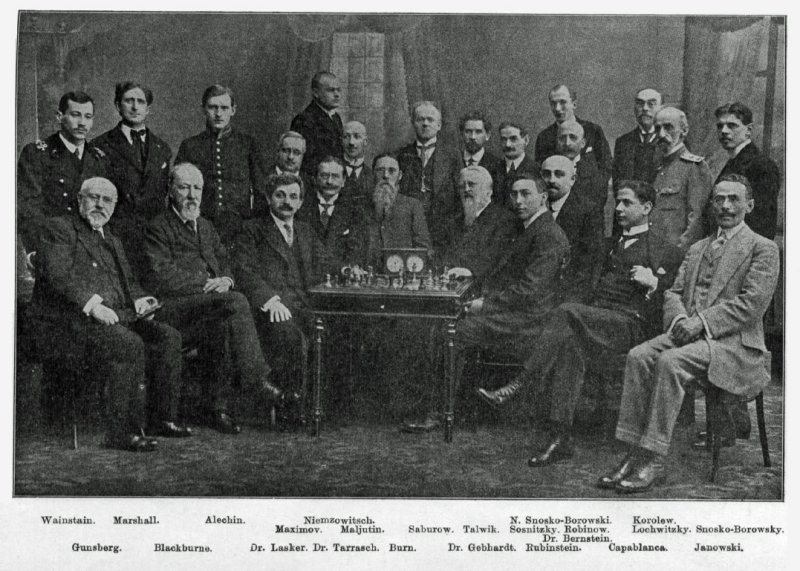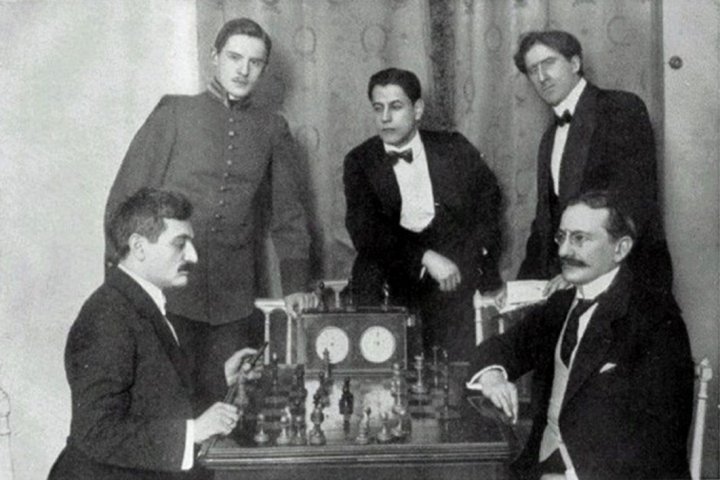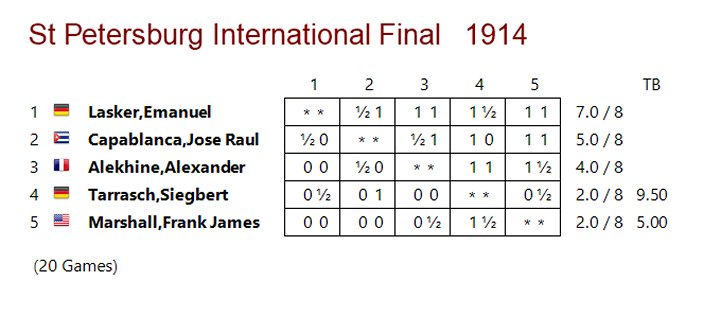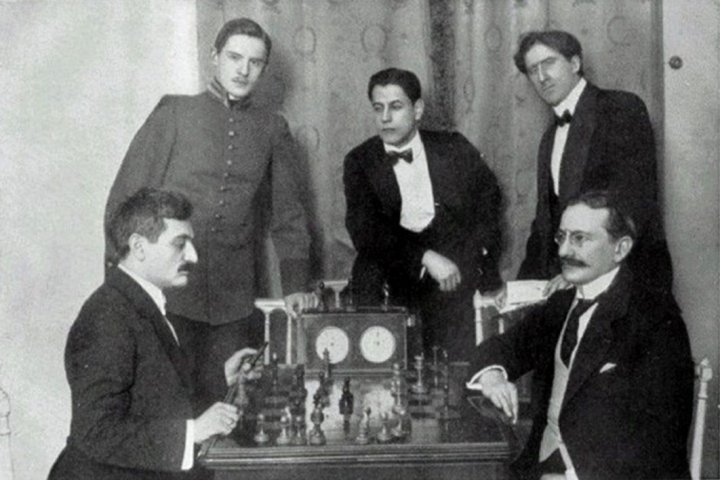The Tournament and its Participants
St. Petersburg 1914 was organized by the St. Petersburg Chess Society to commemorate its tenth anniversary. It invited the world’s top twenty players, but Amos Burn, Richard Teichmann, and Szymon Winawer declined for personal reasons. Oldrich Duras, Geza Maroczy, Carl Schlechter, Rudolf Spielmann, Savielly Tartakower, Milan Vidmar, and Max Weiss, on the other hand, declined due to tensions between Russia and Austria-Hungary.
The remaining eleven, nonetheless, made a formidable cast. These included the world champion in Emanuel Lasker, the leading title contenders in Akiba Rubinstein and Jose Raul Capablanca, former world championship contenders in Isidor Gunsberg, Frank Marshall, Siegbert Tarrasch, and David Janowski, a 19th century great in Joseph Henry Blackburne, a leading Russian master in Ossip Bernstein, and the joint winners of the 1913 All-Russian Masters Tournament in Alexander Alekhine and Aron Nimzowitsch.

The tournament adopted a unique format where a preliminary stage was played to select five finalists. The five finalists then played each other twice in the succeeding stage, with their scores in the preliminaries carried over.
For one month, at least, chess took center stage. Europe suddenly seemed oblivious to the coming of the Great War, and the nations’ wires rumbled with reports of the great event. The hall wasn’t large enough for the crowd, and the enchantment therein could well have spoken to the similar excitement that exploded across the whole continent. One journalist captured the scene strikingly:
Spectators were packed in unceremoniously like sardines in a barrel. They craned their necks; they stood on tiptoes, even on chairs, so they could see the play…and the room was so thick with tobacco smoke…
The five who qualified for the finals at the end of the preliminaries were Capablanca, Lasker, Tarrasch, Alekhine, and Marshall. Capablanca cut through the competition, and left Lasker and Tarrasch in a distant second, 1.5 points behind. Alekhine and Marshall were a farther 2 points behind Capablanca.
 What followed in the finals was a race for the ages between Lasker and Capablanca. Capablanca kept his fine form, but Lasker caught fire and tied Capablanca before their crucial encounter in the 7th round.
What followed in the finals was a race for the ages between Lasker and Capablanca. Capablanca kept his fine form, but Lasker caught fire and tied Capablanca before their crucial encounter in the 7th round.
Although they were tied for the lead, Lasker, in fact, had only three games remaining to Capablanca’s four, as Capablanca had taken his bye earlier. Lasker practically had to win to have any fighting chance for first.
Everyone, including Capablanca, expected Lasker to fight and play sharply. In a psychological masterstroke, however, he chose a quiet, Queen-less game and did beat Capablanca. Lasker remembers the moment of Capablanca’s resignation:
From the several hundred spectators there came such applause as I have never experienced in all my life as a chess player. It was like the wholly spontaneous applause which thunders forth in the theater, of which the individual is almost unconscious.”
The name Emanuel Lasker will always be linked with his incredible 27 years reign on the throne of world chess. In 1894, at the age of 25, he had already won the world title from Wilhelm Steinitz and his record number of years on the throne did not end till 1921 when Lasker had to accept the superiority of Jose Raul Capablanca. But not only had the only German world champion so far seen off all challengers for many years, he had also won the greatest tournaments of his age, sometimes with an enormous lead. The fascinating question is, how did he manage that?
The game has become very famous and the strategy Lasker employed of drawing the opponent into a slow, maneuvering game in a must-win situation has proven effective in modern play. It is the same strategy Garry Kasparov adopted in the 24th game of the 1987 World Championship against Anatoly Karpov in Seville, Spain, to retain his title.

The five finalists (from left to right): E. Lasker, A. Alekhine, J. Capablanca, F. Marshall, S. Tarrasch
Capablanca was so taken aback by the loss that he also lost to Tarrasch in the following round. That meant Lasker, who took a bye, had a one-point lead over Capablanca with two games remaining for them.
In the penultimate round, Lasker only drew with Tarrasch while Capablanca won over Marshall, cutting Lasker’s lead to half a point. In the final round, Capablanca won again, this time against Alekhine, but Lasker also beat Marshall. It was a mad dash to the finish and Lasker won the great tournament by the slimmest of margins.

Significance of the Tournament and its Results
Tournaments like St. Petersburg 1914 can make or break a player and, certainly, much was at stake for all the participants. All told, if the dynamics and pecking order of the world championship were to be considered, then the results proved very consequential to Lasker, Capablanca, Alekhine, and Rubinstein.
For Lasker, it was with such impressive performances that he built and groomed his legend. He had been world champion for close to twenty years and already had a string of similar victories in St. Petersburg 1896, London 1899, and Paris 1900, but St. Petersburg 1914 had to be his finest performance. Ten years later, he would also win the equally-great New York 1924. In Moscow 1935, he went unbeaten in a field that included a new generation of Russian stars, and this performance is considered to be the greatest for a sixty-five-year-old. All these left Alekhine in awe and convinced him that, as a tournament fighter, there was no one like Lasker.
Quite remarkably, St. Petersburg was Lasker’s first tournament in five years. His other pursuits like Mathematics and Philosophy had left him busy, and he had refused other strong tournaments in the preceding years because of his demand for considerable fees. To win a tournament of the caliber of St. Petersburg under those circumstances is nothing short of unthinkable. Lasker was an intellectual force, and he did not need to keep himself abreast with all the latest fine points of theory. Chess, for him, was a battle of will and logic, and he would, time and again, prove himself superior to his peers at it.
For Capablanca, second place was an unfortunate finish after he had led comfortably, but it did not diminish the awe everyone had given him since San Sebastian 1911. Whether it all happened by sheer ill-luck or by Lasker’s uncanny ability to rally, Capablanca had to be Lasker’s next challenger.
He was a child prodigy and he is surrounded by legends. In his best times he was considered to be unbeatable and by many he was reckoned to be the greatest chess talent of all time: Jose Raul Capablanca, born 1888 in Havana.
If anything, Capablanca’s finish only whet everyone’s interest in a world championship match. While many had thought he would surely defeat Lasker, the outcome suddenly seemed uncertain. Lasker had snatched glory from Capablanca’s grasp, and he could well do it again defending his title.
All these rumblings, however, were cut short, as World War I broke out two months after the event. It would take another seven years for the match to happen.
For Alekhine, his third-place finish either meant that he had overachieved or had clearly been underrated coming into the event. Not much was expected from him in the first place, as in his last two international appearances, the 17th Congress of the German Chess Union in 1910 and Carlsbad 1911, he did not perform well. Alekhine was given his stage, and the chess world saw a new star who would shine for a long time.
St. Petersburg made Alekhine aware of his power and true potential. At the tournament’s end, only the world champion and his rightful challenger were above him, and he reckoned that with hard work he could someday become world champion himself. Thus began his single-minded drive for the world championship, and he would keep his ambitions aflame despite rough patches in the coming war and the Russian Revolution. He would beat Capablanca in their 1927 World Championship match, realizing his dream that may well have begun in the halls of St. Petersburg.
On this DVD GMs Rogozenco, Marin, Müller, and IM Reeh present outstanding games, stunning combinations and exemplary endgames by Alekhine. And they invite you to improve your knowledge with the help of video lectures, annotated games and interactive tests
For Rubinstein, the tournament was a disaster, and perhaps no great player in history has had to bear the tragic consequences of one poor performance as he did. He had been the leading title contender since winning five international competitions in 1912, and negotiations for a match with Lasker, in fact, were progressing before the start of the tournament. His failure to advance to the finals, however, coupled with Capablanca’s stellar performance, dislodged him from the contender’s perch.
Worse, his displacement in the war and mental disorder soon hampered him such that he faded from world championship contention altogether. He still performed strongly in the 1920s and even won gold medal for Poland at the Olympiad late in his career, but his opportunity for a world championship match was likely shut in St. Petersburg.
In all, St. Petersburg 1914 led to significant consequences in elite chess and tipped the balance of ascendancy among the leading world championship contenders. For this reason, it is remembered not only as a sporting spectacle but as a very important historical chess event as well.
Games
Lasker vs. Capablanca (Round 7, Finals) – The famous game in which Lasker grabbed the lead from Capablanca.
Capablanca vs. Bernstein (Round 7, Preliminaries) – Capablanca embarks on a beautiful, sacrificial attack. This game won the tournament’s first brilliancy prize.
Nimzowitsch vs. Tarrasch – (Round 5, Preliminaries) – a game featuring the classic double bishop sacrifice that won the second brilliancy prize for Tarrasch.
Blackburne vs. Nimzowitsch (Round 8, Preliminaries) – The old guard Blackburne plays a strong, attacking game and demonstrates that he can cross swords with the modern masters. This game won the tournament’s special brilliancy prize.
Alekhine vs. Marshall (Round 4, Preliminaries) – Alekhine was a tactical genius, but he shows his versatility by playing a simple, fine endgame against the American champion.
Links



















 What followed in the finals was a race for the ages between Lasker and Capablanca. Capablanca kept his fine form, but Lasker caught fire and tied Capablanca before their crucial encounter in the 7th round.
What followed in the finals was a race for the ages between Lasker and Capablanca. Capablanca kept his fine form, but Lasker caught fire and tied Capablanca before their crucial encounter in the 7th round.






